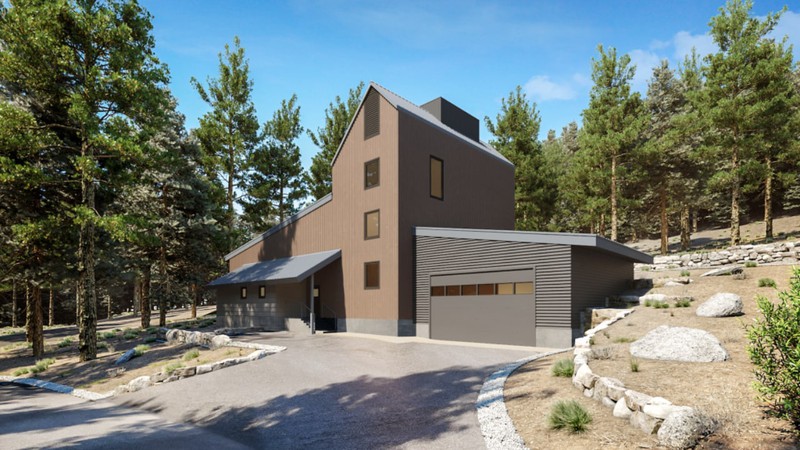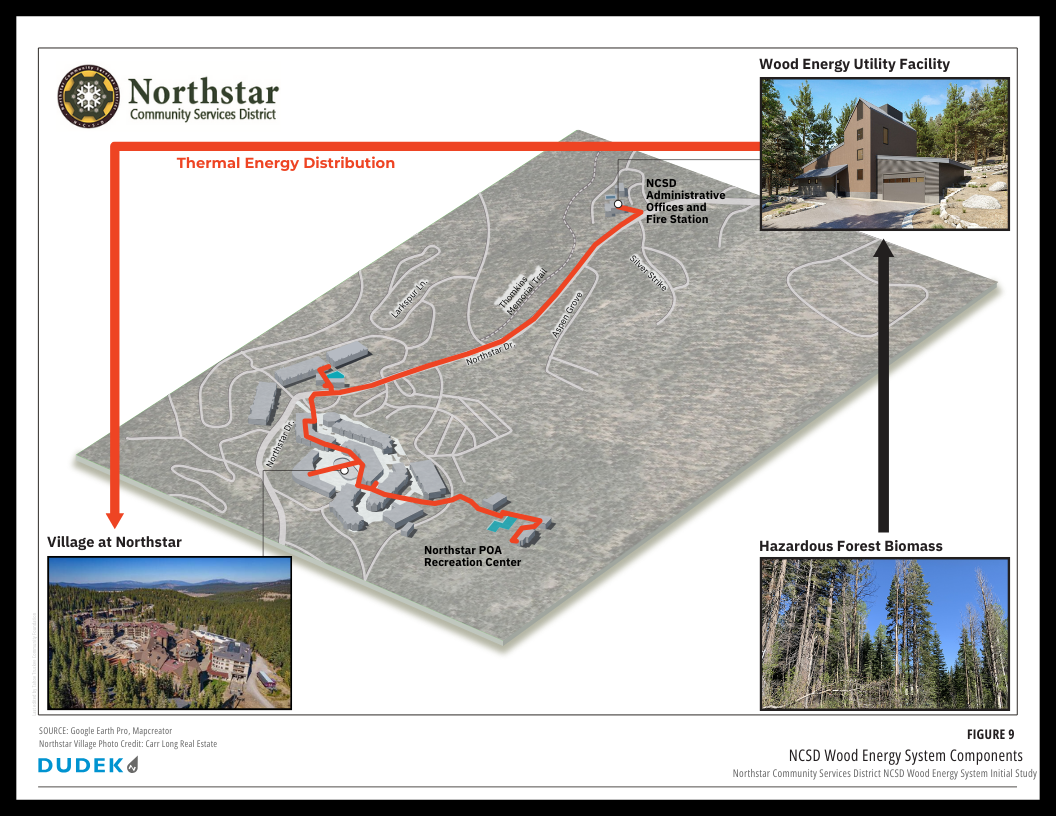For the good of Tahoe Truckee forests and communities, funders & local leaders rally to support Northstar Community Services District wood energy facility.

This 6,000 square foot structure, a two-boiler system, will help dispose of dangerous biomass by burning wood chips to boil water, providing heat to buildings in Northstar Village.
Not too long ago, a local project to thin the forest along a bike path was delayed by two seasons. Why? Because of community resistance and perception. With so many beautiful trees, why would we want to remove any?
For centuries, natural fires and indigenous practices helped protect our forests by removing excess trees and shrubs so they did not become overcrowded. In the early 1900s, several major wildfires catalyzed a nationwide effort to stop fires as soon as possible. After over a century of immediate fire suppression, and recent drought and bark beetle infestation, our forests are being pushed to dangerous extremes. The woody fuels – living trees, shrubs, or trees that are dried and dead from drought and bark beetle – have overwhelmed the forest ecosystem and our communities. As a result, catastrophic wildfires are increasing throughout the West; in 2021, two of them flanked the North Tahoe-Truckee region, and the Caldor Fire entered the Tahoe Basin.
We now know that responsible forest management and protecting our communities from wildfire requires intentional fuel reduction efforts with the thinning of excess trees and removal of shrubs and underbrush. Where that woody biomass goes after being removed is the next step in solving the forest health crisis. One solution is garnering widespread support here in our own backyard: The Northstar Community Service Districts (NCSD) Wood Energy Facility.
Northstar Wood Energy Facility: A Full Circle Solution for Forested Communities
It is estimated that the North Tahoe-Truckee region needs to dispose of upwards of 100,000 Bone-Dry-Tons (BDT) per year of woody biomass. For reference, one BDT equates to approximately 2,000 pounds of wood that is bone dry.
Biomass encompasses a wide range of materials, with the type and size of biomass significantly influencing its quality and market value. Larger trees can be used for lumber used in construction, but smaller trees, shrubs, and branches have a lower market value and are expensive to transport. The most sustainable, and even profitable, solution for woody biomass disposal is local biomass utilization facilities. Over the years, dozens of local leaders within public agencies and nonprofits have looked for opportunities to solve this challenge. Many in our community see the NCSD Wood Energy Facility as a catalytic step in doing just that– acting as a blueprint for our region and for American West forest ecosystems and communities that are facing the same issues.
The NCSD Wood Energy Facility focuses on lower market value biomass. In a 6,000 square foot structure, a two-boiler system would burn wood chips to heat water, providing heat to a majority of buildings (fourteen in total) and several pools in Northstar Village. The boilers will provide 99% of the average thermal demand, directly offsetting natural gas demand. The byproduct (ash) will be delivered for agricultural use to Sierra Valley farms. It is estimated the project will result in a net reduction of up to 75,000 metric tons of carbon dioxide over its lifecycle.
Small biomass facilities are common in other parts of the world and have even demonstrated value just north of our region in Quincy. In 2018, The Sierra Institute completed the installation of a biomass facility that heats the Plumas County Health and Human Services Center. Learning from their success, the Northstar facility has received significant public support as a full-circle solution that can be replicated throughout the region. It truly begins to solve a significant challenge that remains top of mind for community leaders.
Capital Stacked: Public, Private, and Philanthropic Funders Come Together
Projects like this one require wide public support, permits, and funding. NCSD has been working diligently to win all three, providing ongoing community education sessions, engaging local journalists, and writing extensive grant proposals.
The direct capital costs of the project total $8.6 Million. Reaching that goal requires a blend of public and private funding from local, state, and federal entities, the largest dollars often coming from public funders. So far, the wood energy facility has secured public funding and pro bono services from Placer County Water Agency, USDA Forest Service and CAL FIRE, with others still pending.
Tahoe Truckee philanthropic funders have been eager for innovative forest health solutions. For years, they have been dedicated to educating their stakeholders– including board members, donors, regional partners, and community members– on the complexity of forest ecosystems and solutions that are being explored regionally and across the world. Advocacy and education are key pieces of building public support and readying stakeholders to invest in opportunities when they arise. When NCSD first proposed the biomass facility, the region was well-educated about woody biomass and the potential ripple impact of a local processing facility.
Once project fundraising began, corporate and community philanthropy organizations were poised to help leverage public and private grants to support the effort. Demonstrating the power of corporate philanthropy, Vail Resorts committed guest donations through their EpicPromise program and the Tahoe Fund’s $1 for Tahoe program. Community philanthropy aligned through Martis Camp Foundation, Martis Fund, Tahoe Mountain Resorts Foundation, and Tahoe Truckee Community Foundation. These regional funders recognize the power of collective action to catalyze innovation, provide nimble and flexible funding, and represent community support. In fact, CAL FIRE noted that such unification out of a smaller region was one of the main reasons the project received their funding.
NCSD is, in many ways, providing a roadmap for other biomass facilities to come to fruition. Even when large grant dollars come to the table, biomass facilities will need multi-year service agreements to ensure that energy produced at facilities will be purchased and used, guaranteeing that the facilities don’t sit idle. In this case, NCSD will partner with various ownership associations that oversee the buildings and facilities that will be purchasing the heat. Any net operating proceeds will be reinvested in ongoing risk reduction and forest management activities to maintain a healthy, resilient forest. By responsibly stewarding our forests, creating defensible space, and sustainably disposing of woody biomass, we can ensure that community assets and private property retain fire insurance and remain protected if the worst does occur.
The Future of Our Forests is in Our Hands
Construction on the facility is slated to commence this year, in 2024, with a goal of completion in 2025. Heat delivery is anticipated as early as the Spring of 2025.
In many ways, this project is carving a path for other projects to follow that will need the same level of support and engagement that Northstar is receiving. If you live, work, or visit this region, you have a major stake and responsibility in protecting this beautiful place. Please engage in the conversation, educate yourself on the issues, and act in ways that provide public support for this important work. If you donate to local causes, please consider donating to the philanthropic funds that align with this and other forest health projects.

California Local partners with organizations and agencies whose work we support to help them tell their stories.